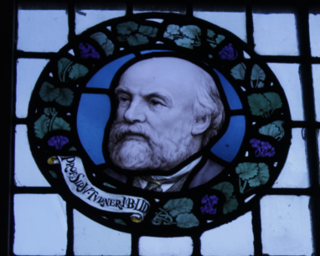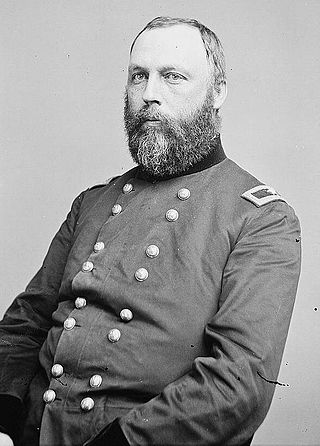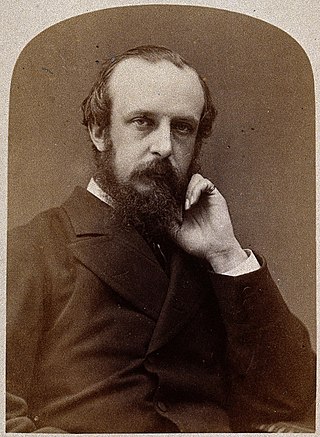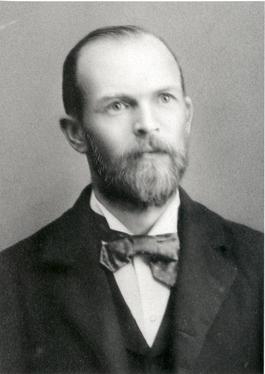Related Research Articles

Joseph Lister, 1st Baron Lister, was a British surgeon, medical scientist, experimental pathologist and a pioneer of antiseptic surgery and preventative medicine. Joseph Lister revolutionised the craft of surgery in the same manner that John Hunter revolutionised the science of surgery.

Sir Charles Scott Sherrington was an eminent English neurophysiologist. His experimental research established many aspects of contemporary neuroscience, including the concept of the spinal reflex as a system involving connected neurons, and the ways in which signal transmission between neurons can be potentiated or depotentiated. Sherrington himself coined the word "synapse" to define the connection between two neurons. His book The Integrative Action of the Nervous System (1906) is a synthesis of this work, in recognition of which he was awarded the Nobel Prize in Physiology or Medicine in 1932.

Robert Bentley was an English botanist. He is perhaps best remembered today for the four-volume Medicinal Plants, published in 1880 with Henry Trimen and containing over three hundred hand-colored plates by botanist David Blair.

Edward Headlam Greenhow FRS, FRCP was an English physician, epidemiologist, sanitarian, statistician, clinician and lecturer.

Sir Benjamin Ward Richardson was a British physician, anaesthetist, physiologist, sanitarian, and a prolific writer on medical history. He was the recipient of the Fothergill gold medal, awarded by the Medical Society of London in 1854 and of the Astley Cooper triennial prize for an essay in physiology.

Sir William Turner was an English anatomist and was the Principal of the University of Edinburgh from 1903 to 1916.

William Alexander Hammond was an American military physician and neurologist. During the American Civil War he was the eleventh Surgeon General of the United States Army (1862–1864) and the founder of the Army Medical Museum.
James Lawson Drummond was an Irish physician, naturalist and botanist.

Dr John Epps was an English physician, phrenologist and homeopath. He was also a political activist, known as a champion of radical causes on which he preached, lectured and wrote in periodicals.

Sir Andrew Douglas MaclaganPRSE FRCPE FRCSE FCS FRSSA was a Scottish surgeon, toxicologist and scholar of medical jurisprudence. He served as president of 5 learned societies: the Royal Medical Society (1832), the Royal College of Surgeons of Edinburgh (1859–61), the Royal College of Physicians of Edinburgh (1884–87), the Royal Society of Edinburgh (1890–5), and the Royal Scottish Society of Arts (1900).

John Syer Bristowe (1827–1895) was an English physician.

Christopher Heath FRCS was an English anatomist and general surgeon

William Tyler Smith (1815–1873) was an English obstetrician, medical writer and journalist, with outside interests in insurance and the development of Seaford, East Sussex, U.K.
Joseph Reynolds Green (1848-1914) was an English botanist, physiologist and chemist whose research into plant enzymes was influential in the development of the discipline of biochemistry. He held the chair in Botany at The Pharmaceutical Society of Great Britain and lectured at the University of Liverpool and Downing College, Cambridge. In 1895 he was elected a Fellow of the Royal Society.
Professor Anthony Turner Andreasen was an eminent surgeon, Chair of Surgery at Orissa Medical School, Chair of Surgery at the Calcutta Medical College, Surgeon to the Viceroy of India, Fellow of Surgery at Johns Hopkins University, Government Surgeon in Ghana and Uganda, author, and in his later years Professor of Surgery at the University of Cambridge.

Emily Winifred Dickson was an Irish doctor who was the first female fellow of the Royal College of Surgeons in Ireland. She was also the first female fellow of any of the Royal Colleges of Surgery in Great Britain and Ireland.

Robert Nasmyth FRCSEd, FRSE was a Scottish dental surgeon from Edinburgh who was Surgeon-Dentist to Queen Victoria in Scotland. He was President of the Odonto-Chirurgical Society of Scotland and was one of the founders of the Edinburgh Dental Dispensary, which would evolve into the Edinburgh Dental Hospital and School.
Dr David Lloyd Roberts FRSE FRCP (1835–1920) was a 19th-century British gynaecologist and bibliophile.

William Keiller was a Scottish born anatomist who trained in anatomy at the Edinburgh Extramural School of Medicine and was appointed as the first Professor of Anatomy at the University of Texas Medical Branch (UTMB) at Galveston, a post he held for 40 years. He served as Dean of the UTMB Medical School and as President of the Texas Medical Association. Many of his anatomical drawings and paintings are preserved and displayed at the Blocker History of Medicine collection at UTMB Moody Medical Library.
Extramural medical education in Edinburgh began over 200 years before the university medical faculty was founded in 1726 and extramural teaching continued thereafter for a further 200 years. Extramural is academic education which is conducted outside a university. In the early 16th century it was under the auspices of the Incorporation of Surgeons of Edinburgh (RCSEd) and continued after the Faculty of Medicine was established by the University of Edinburgh in 1726. Throughout the late 18th and 19th centuries the demand for extramural medical teaching increased as Edinburgh's reputation as a centre for medical education grew. Instruction was carried out by individual teachers, by groups of teachers and, by the end of the 19th century, by private medical schools in the city. Together these comprised the Edinburgh Extramural School of Medicine. From 1896 many of the schools were incorporated into the Medical School of the Royal Colleges of Edinburgh under the aegis of the RCSEd and the Royal College of Physicians of Edinburgh (RCPE) and based at Surgeons' Hall. Extramural undergraduate medical education in Edinburgh stopped in 1948 with the closure of the Royal Colleges' Medical School following the Goodenough Report which recommended that all undergraduate medical education in the UK should be carried out by universities.
References
- 1 2 3 4 5 6 7 8 9 10 11 "Samuel Hoppus Adams, M.D. Lond". Br Med J. 1 (1785): 621. 1895. doi:10.1136/bmj.1.1785.621. PMC 2508253 .
- ↑ "Irish Medical Directory". 23 October 1859 – via Google Books.
- ↑ "The Lancet London: A Journal of British and Foreign Medicine, Surgery, Obstetrics, Physiology, Chemistry, Pharmacology, Public Health and News". Elsevier. 23 October 1857 – via Google Books.
- ↑ Club, Bedfordshire Natural History Society and Field (23 October 1877). "Abstract of Proceedings and Transactions of the Bedfordshire Natural History Society, and Field Club". at the Society's rooms, County Library – via Google Books.
- 1 2 BMD, England
- ↑ "The Medical Times and Gazette: A Journal of Medical Science, Literature, Criticism, and News". 24 October 1858 – via Google Books.
- 1 2 The Times , September 26, 1857, p. 9
- ↑ Health Of London: Week Ending August 15th, 1857. (1857). The British Medical Journal, 2(34), 724–726. http://www.jstor.org/stable/25191595
- ↑ "The Lancet London: A Journal of British and Foreign Medicine, Surgery, Obstetrics, Physiology, Chemistry, Pharmacology, Public Health and News". Elsevier. 23 October 1857 – via Google Books.
- ↑ "The Educational Times, and Journal of the College of Preceptors". Charles Francis Hodgson. 23 May 1861 – via Google Books.
- ↑ The Daily Telegraph , Thursday, December 5, 1861, p. 3
- ↑ ltd, Kelly's directories (24 October 1885). "Kelly's directory of Bedfordshire, Hunts, and Northamptonshire" – via Google Books.
- ↑ The Eagle, The Magazine of Bedford Modern School, Vol. III (1888), p. 243